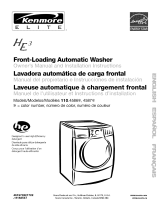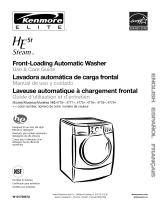
1. Checktheelectricalrequirements.Besurethatyouhavethe
correctelectricalsupplyandtherecommendedgrounding
method.(See"ElectricalRequirements.")
2. Checktobesureallpartsarenowinstalled.Ifthereisan
extrapart,gobackthroughthestepstoseewhichstepwas
skipped.
3. Check to be sure you have all of your tools.
4. Dispose/recycle all packaging materials.
5. Check to be sure the water faucets are on.
6. Check for leaks around faucets and inlet hoses.
Electrical Shock Hazard
Plug into a grounded 3 prong outlet.
Do not remove ground prong.
Do not use an adapter.
Do not use an extension cord.
Failure to follow these instructions can result in
death, fire, or electrical shock.
7. Plug into a grounded 3 prong outlet.
8. Read "Washer Use."
9. Totest and to clean your washer, measure 1/2the normal
recommended amount of powdered or liquid High Efficiency
(HE) detergent or 1/4the normal recommended amount of
regular powdered or liquid detergent. Pour the detergent into
the detergent dispenser. Select NORMAL/CASUAL, and then
select START. Allow the washer to complete one whole cycle.
FEATURES AND
BENEFITS
SENSOR SMART TM Electronic Controls
Flexible electronic controls are easy to use whether you are a
beginner or an expert.
Detergent Advantage System Dispenser
The four compartments in the dispenser allow loading of all
laundry additives before the washer is started. The additives will
be dispensed into the wash at the optimal time for high
performance cleaning. TIMED BLEACW Mrelease is included in
the detergent advantage system. The detergent is added at the
beginning of the cycle and the bleach is added after the enzymes
have had a chance to do their cleaning. The fabric softener is
dispensed in the rinse cycle. The Detergent Advantage System
Dispenser tray is easily removed for cleaning.
Auto Water Level
Adjusting to the size of the load, this feature allows the washer to
use the minimal amount of water needed to clean and rinse the
clothes. With a low water level, you can obtain the same results
with smaller amounts of additives. Because only the required
amount of water is used, the washer saves energy, too.
Larger Load Size
Since there is no agitator, you can wash larger, bulkier items like
an average size sleeping bag. You are also able to wash more
clothes at one time, which means fewer loads. You can wash a
pillow or a large stuffed teddy bear.
Suspension System
To reduce washer "walk" and "off-balance" conditions, your new
washer combines:
• 2 Springs to isolate vibration
• 4 Shock absorbers at the washer base to minimize movement
Stainless Steel Drum
The Stainless Steel drum eliminates corrosion and enables higher
spin speeds for more water extraction, reducing drying time.
Adaptive Variable Speed Motor
The motor adapts to the load size and to the cycle selected to
give the optimum cleaning, rinsing, and spinning conditions. The
motor can handle slow speeds needed for wool and delicate
items and is powerful enough to drive a large clothes load into a
1,200 rpm spin.
High-Efficiency Wash System
Your new front-loading, high-efficiency washer saves time with
fewer, larger loads, conserves resources and lowers your water
and energy bills too.
Spin Speeds
This washer automatically selects the spin speed based on the
cycle selected. This factory setting can be changed, however.
This washer offers up to six different spin speed choices.
Thermal Optimizer
The heating system ensures that the wash water is heated to the
preset temperature for Heavy Duty, Whitest Whites, Sanitary, and
the Stain Treat option. It also provides "stepped cleaning" when
using the sanitary cycle or the stain treat option. "Stepped
cleaning" starts the wash cycle with warm water to remove stains
(such as blood or grass). The water continues heating in order to
remove stains such as dirty mechanical oil. During the sanitary
cycle, the thermal optimizer can heat the water to temperatures
that will destroy 99.999% of three common types of bacteria
found in soiled laundry.
Add A Garment
When lighted, Express Wash, Normal/Casual, Heavy Duty,
Whitest Whites, and Sanitary can be paused and the door
unlocked so you can add a garment that may have been
forgotten when loading the washer. The ADD A GARMENT status
light will stay lit for the first 8 minutes of a cycle.
CATALYST _ Cleaning Action with Direct Injection
A concentrated detergent solution is sprayed onto the clothes at
the beginning of the cycle to ensure that the detergent comes
into contact with the clothes as quickly as possible, removing
stains from your clothes without pretreating.
Dynamic Balance
A precision balancing system that allows the washer to reach
spin speeds of 1,200 rpm. The washer spins faster so that
clothes coming out of the washer will dry faster. In addition, if the
Dynamic Balance system detects off balance loads during
spinning, it redistributes the clothes so that they are evenly
balanced.
10


























